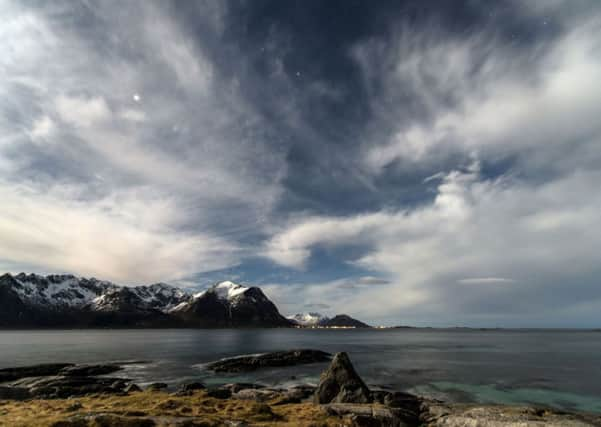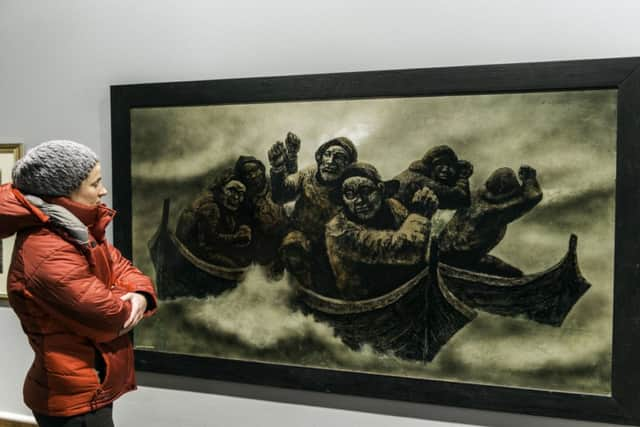Lofoten Islands: My kingdom for a Norse


Glinting brightly in the sharp morning light, thousands of glassy eyes look down. Yet not one of the vacant stares reveals the slightest hint of life.
It’s an unnerving to stand beneath a canopy festooned with dead bodies, but at this time of year in Norway’s remote Lofoten Islands, it’s almost unavoidable. It’s late February, and one of the world’s most important cod fisheries is in full swing. During winter months, thousands of Arctic cod migrate south from the Barents Sea to spawn and, like generations before them, fishermen from all over Norway come here to join the marine gold rush.
Advertisement
Hide AdAdvertisement
Hide AdWhat I’m standing under is a hjell, a large wooden triangular rack where fish are dried by sun and wind for 12 weeks. It’s an eery sight, but even more powerful is the smell. A sweet, fishy odour hangs above the islands.


There’s no doubt these dead fish are – and always have been – a lifeline for residents on the Lofoten islands. Some of the earliest fishermen were the Vikings, and cod formed an important part of their diet. Legends abound about Norwegian Viking boats being seized in Europe and supplies of stockfish eagerly confiscated.
It’s tales of these Norse warriors that have brought me to the wild archipelago in the Arctic Circle, which, although today unfamiliar to many, was once one of the most important Viking sites.
In 1983, archaeologists on the island of Vestvagoya uncovered ruins of what is believed to be the largest Viking longhouse ever found. A reconstruction now exists as the Lofotr Visitor Centre in small village Borg, where costumed actors serve mead in a grand banqueting hall.
Advertisement
Hide AdAdvertisement
Hide AdA replica also forms the centrepiece of the British Museum’s new blockbuster exhibition, Vikings: Life and Legend, which runs in London until June 22. But the functional grey walls of the new Sainsbury’s Exhibition Galleries are no substitute for experiencing the windswept, unforgiving landscapes of the Vikings’ true stomping grounds.
While the majority of tourists visit Lofoten in summer, when the midnight sun makes it a hiker’s paradise, the landscapes are equally – if not more – captivating during colder months.
Mountains rise, sabre-like, from the rough Norwegian Sea, higher peaks swathed in heavy mist. Some rocks are smooth and rounded, while others form sharp peaks, like waves in a fierce storm frozen at their crest.
Human settlement here dates back 11,000 years, but as I step off the small propeller plane, it feels as if I’m one of the first people to arrive. My base for the next few days is Svolvaer, the archipelago’s capital, where I book into one of the waterfront red timber cabins at Svinoya Rorbuer.
Advertisement
Hide AdAdvertisement
Hide AdDraped with frayed fishing nets and weathered buoys, the cosy self-catering properties have been designed in the style of fishermen’s houses. Modern replicas of oil lamps hang in the windows; a tradition practised by anxious wives waiting for the husbands to return home from sea.
To get an idea of what life at sea must have been like in the past, I visit Storvagan, one of the first fishing villages in Lofoten and an important European trading post in the 1300s. A short film playing at the Lofotmuseet features many of the lighthouse keepers who, up until 20 years ago, lived with their families (and later alone) at the edge of the world.
“The periods of foul weather were the best,” recalls one nostalgic keeper. “We knew no-one would be coming for a while so we’d be left in peace to do what we wanted.”
One person who really understood the harsh beauty of Lofoten and portrayed it through his illustrations and lithographs was Norwegian artist Kaare Espolin Johnson, on show at the Galleri Espolin.
Advertisement
Hide AdAdvertisement
Hide AdOne striking image show a fisherman who would sail for three hours just to feed his sheep; the rugged lines on his drawn face proof that life had physically worn him down.
“This isn’t an easy place,” says Jann Engstad from Lofoten Aktiv, whose family has lived on the islands since 1608. “But what we have here is very special.”
Jann takes me on a Northern Lights hunt later that night, driving through snow-filled and icy valleys looking for a clear gap in the clouds. The full moon is so bright we don’t even need torches to find our way as we scramble along the rocky coastline. “This is one of the best places to see Northern Lights,” he says.
“We get the same displays as Tromso but we don’t have the packed busloads of people. What we have here is solitude and that’s wonderful.”
Advertisement
Hide AdAdvertisement
Hide AdIn 90 days, Jan boasts he’s only had to cancel 10 trips and failed to see the lights just three times. Tonight adds another strike to that list as unfortunately, Lady Aurora is not shining.
The Vikings believed the lights were the reflection of a grand battle taking place in the sky, the flashing armour of Valkyries flying down to fetch dead souls. I don’t encounter any battle mistresses on my travels, but I do witness winged warriors of a different sort.
Northern Norway is home to the world’s densest population of sea eagles, and a sea safari with Lofoten Charter Boat takes me to the Trollfjord and along an area of coastline where the birds regularly come to fish.
Within minutes they begin to circle, their 2.7m wingspan casting shadows on the mountains.
Advertisement
Hide AdAdvertisement
Hide AdIn the sunlight, patches of water shimmer a Caribbean turquoise green, but I’ve come to realise these are castaway islands of a very different sort.
Rugged, wild, fearsome and marvellous; the Vikings couldn’t have chosen a more apt place to call home.